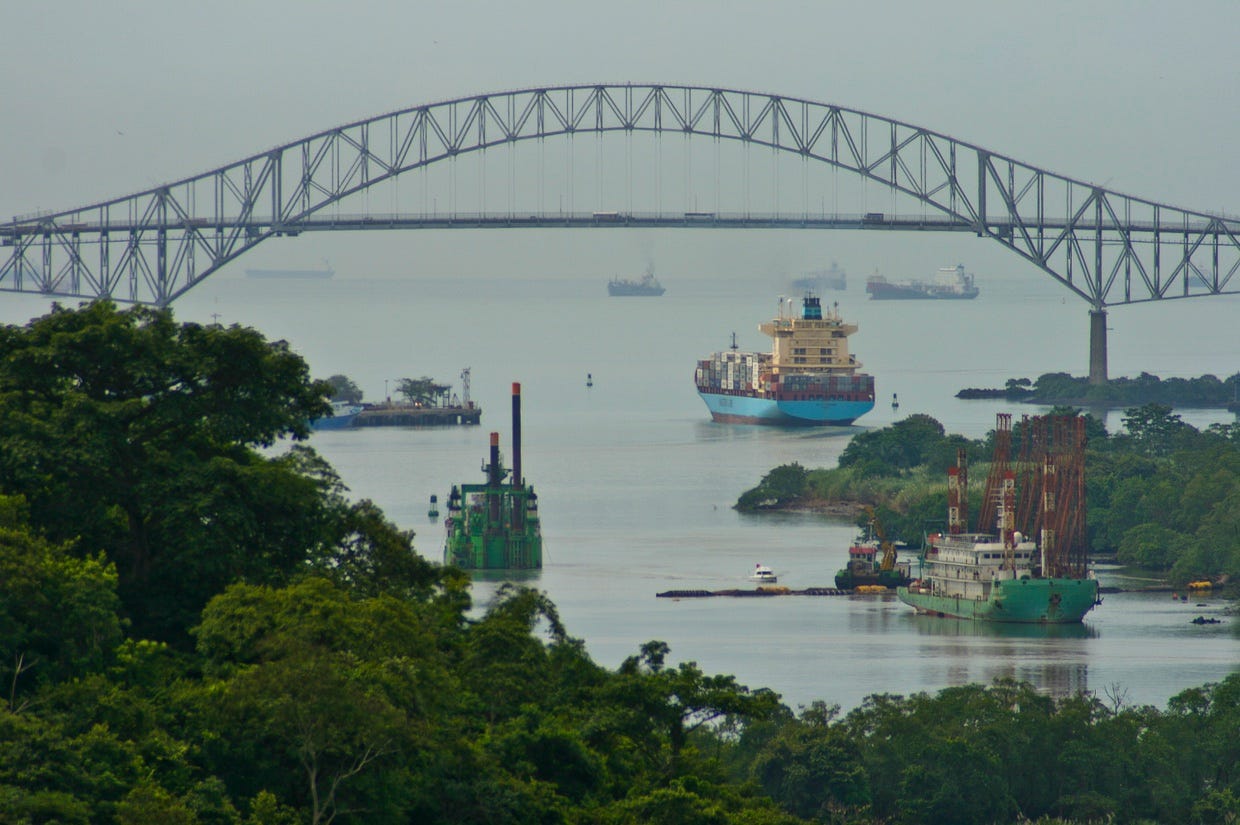History's next lesson, from the drought in Panama
February 14, 2024
“(N)o statistic conveyed a true picture of Panama rain. It had to be seen, to be felt, smelled; it had to be heard to be appreciated. The effect was much as though the heavens had opened and the air had turned instantly to liquid.”—historian David McCullough, The Path Between the Seas, 1977
The Bridge of the Americas, spanning the Pacific entrance to the canal near Panama City. (photo courtesy Wikimedia images)
Three miles inland from where the Panama Canal reaches the Bay of Panama there is a tidal basin of channels, bays and mud flats. My boyhood friend Bobby Orvis had one of his happier days here. Just as the Pacific tide was preparing to leave with our fishing waters he began landing one blowfish after another with his hand lines, so much so that I gave up my own gear to begin clearing his. Blowfish have powerful jaws and very large front teeth. So when a mature specimen gets a bite on your fingers--as one did on mine--it is a memorable experience.
“Jeezus Connor!” Bobby exclaimed, with equal notes of laughter and alarm.
In ways I can’t ably convey, the scene really was as funny as it was bloody, and we were both laughing as it unfolded; even as I was trying to staunch the bleeding. The inflated fish had made its point, on behalf of the world’s fishes.
Ferdinand de Lesseps died in December of 1894. I wonder what he would have thought of Bobby and me, two American kids fishing in the mangroves, watching ships bearing tourists, cargo containers, and deck cannons slide past, going from one ocean to the next. The rusted hulk from which we fished had been sent to Panama by de Lesseps—the “Great Engineer,” credited with building the Suez Canal. Now it was the barnacle-encrusted skeleton of a discarded ladder dredge, last used in the 1880s by the Compagnie Universelle du Canal Interoceanique to try to dig a sea level canal across the isthmus. It is a rusty relic of a tragic failure. If you were a French engineer sent to Panama in the late 19th century, it was more likely than not you died there, from malaria or yellow fever.
My grandfather, Charlie Connor, at work in the late 1960s where the Chagres River meets the canal at Gamboa, not far from the epic excavation at Culebra Cut
Bobby and I were there because the Americans learned from the French disaster. Most importantly they’d learned (from English physician Ronald Ross and Alabama-born U.S. Army physician William Gorgas) about mosquitos and the spread of fatal disease. But they’d also witnessed the folly of trying to build a sea-level canal between the oceans which—in the mountainous and geologically unstable terrain between the oceans—was delusional.
The Americans would build a canal with locks, so the transiting ships could be lifted to and lowered from Gatun Lake, a man-made impoundment filled with fresh water from the Chagres River. The astonishing dig through the mountains at “Culebra Cut” (a fascinating geologic goo of blue clay, basalt and several other ingredients) was the epic hard part. But it would have had to have been a much deeper dig to enable the sea level canal the French envisioned. After the canal opened, the unending battle to keep the cut from filling in on itself is what brought my grandfather, Charlie, a blaster, to Panama in the 1940s.
Striking a pose with an unusually dry football at Balboa Stadium, back in the day
Water seems to everywhere in Panama except during the short dry season that typically begins in in late fall and ends in May. Not that it should matter very much to anybody else, but the timing of the heaviest rains—smack at the beginning football season—was punishing to my athletic ambitions. I was a drop-back passer. Most of the games we played were on fields seeded on fill dredged from Culebra— soil that when saturated and churned by cleats became epic mud holes. This can be hours of fun for fullbacks and linebackers, but not so much fun for pass-happy quarterbacks and wide receivers. Suffice to say it’s much harder to grip a football coated in muck.
In the much larger scheme of things, the heavy rains were vital to world commerce. The hydraulic staircase of the canal locks was a brilliant solution, but one that requires more than 50 millions gallons of fresh water, on average, for every transiting ship. That’s enough fresh water for 100 Olympic-sized swimming pools. The water is stored in man-made reservoirs feeding the Chagres, but also in the famously thick and lush rain forest that skirts the Chagres northward into what is now Panama’s Chagres National Park.
To continue reading please subscribe to The Daily Rhubarb
Opening to feature article in the January 2024 issue of Foreign Affairs by Dutch journalist Mie Hoejris Dahl with image of a cargo ship in the Miraflores locks.
—tjc









